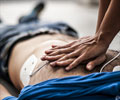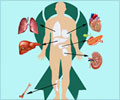About one in 44,000 National Collegiate Athletic Association athletes has sudden cardiac death each year, according to a new study in Circulation: Journal of the American

According to the American Heart Association, athletic training and competition can increase the risk of sudden cardiac death in people with underlying heart disease. Various heart conditions can kill young athletes, including the most common cause — hypertrophic cardiomyopathy, an abnormal growth of heart muscle fibers.
Estimates of the number of such deaths often have been based on inconsistent data sources such as media reports, said Kimberly Harmon, M.D., study author and clinical professor at the University of Washington in Seattle. Also, some studies lack solid figures on how many young people play sports overall, which also affects risk estimates.
The new study used news reports, insurance claims and data from the NCAA, the governing body for intercollegiate sports in the United States. About 400,000 students, ages 17-23, participate in NCAA sports each year.
Researchers tracked deaths from 2004 through 2008 and identified:
- 273 deaths from all causes;
- 68 percent of deaths (187 athletes) from non-medical/traumatic causes;
- 29 percent (80 athletes) from medical causes; and
- 2 percent (6 athletes) from unknown causes.
Of deaths from medical causes, 56 percent (45 athletes) were cardiovascular-related sudden deaths. Of the 36 deaths that occurred during or shortly after exertion, 75 percent (27 athletes) were related to cardiac causes. In all, the study found that one in 43,770 athletes died annually of sudden cardiac death.
Advertisement
- African-American athletes had a sudden cardiac death rate of one in 17,696, compared with one in 58,653 for Caucasian competitors.
- The risk for males was one in 33,134, compared with one in 76,646 for females.
- Basketball had the highest risk of sudden cardiac death, with a rate of one in 11,394. Swimming had the second-highest risk, followed by lacrosse, football and cross-country track.
- The risk of sudden cardiac death in Division I male basketball athletes was about one in 3,000.
Incidence rates often determine whether screening for young athletes should include an electrocardiogram or echocardiogram, said Harmon, a team physician at the University of Washington. "You have to revisit the whole question of whether a more extensive screening makes sense in light of these new numbers," she said. "The question is: where do you set the risk cutoff — one in 10,000, or 40,000, or 100,000?"
Advertisement
The European Society of Cardiology and the International Olympic Committee recommend the addition of electrocardiograms (ECG), a step that the American Heart Association panel considered unwieldy and too costly for large U.S. athlete populations.
"The American Heart Association regards cardiovascular screening for athletes as an important public health issue, for which there are compelling ethical, legal and medical grounds," said Ralph L. Sacco, M.S., M.D., president of the American Heart Association. "We strongly encourage student-athletes and other participants in organized competitive sports to be screened with a careful history, including family history, and thorough physical examination. The American Heart Association also believes healthcare professionals providing the screening should be able to order noninvasive testing when they judge it is needed."
More extensive screening might be practical if targeted at high-risk groups — for instance, basketball players, Harmon said.
Furthermore, automated external defibrillators, used to revive people whose hearts have stopped, could be placed in venues where the highest-risk sports are played, she said.
Source-Eurekalert














